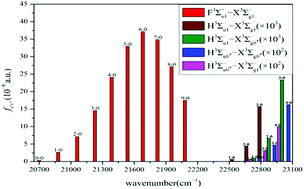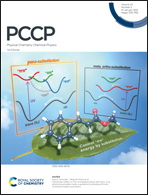Spectroscopic properties and spin–orbit coupling of electronic excited states of the germanium dimer†
Abstract
The electronic structure and spectroscopic properties of the germanium dimer have been investigated by high-level ab initio calculations with consideration of spin–orbit coupling (SOC). The potential energy curves (PECs) of 19 Λ–S states, as well as those of 52 Ω states generated from the Λ–S states, are calculated by the multireference configuration interaction plus Davidson correction (MRCI + Q) method. The properties of the F3Σ+u1−X3Σ−g1 and H3Σ−u1−X3Σ−g1 transitions as well as the interactions of the F3Σ+u and H3Σ−u states with other excited states induced by SOC are investigated based on the calculated SO matrix and the PECs of the Ω states. Our results indicate that the previously observed spectra of Ge2 in the range 20 500–22 000 cm−1 should be assigned as the transition between the Ω = 1g component of the X3Σ−g state and Ω = 1u of the F3Σ+u state. Moreover, owing to the strong SOC with the repulsive 25Πu state, the H3Σ−u state is predissociative, leading to the Ge(3P2) + Ge(3P1) channel at vibrational levels higher than v′ = 6. Our theoretical study would provide comprehensive information and shed light on understanding the spectroscopy and dynamics of the electronic excited states of Ge2.



 Please wait while we load your content...
Please wait while we load your content...